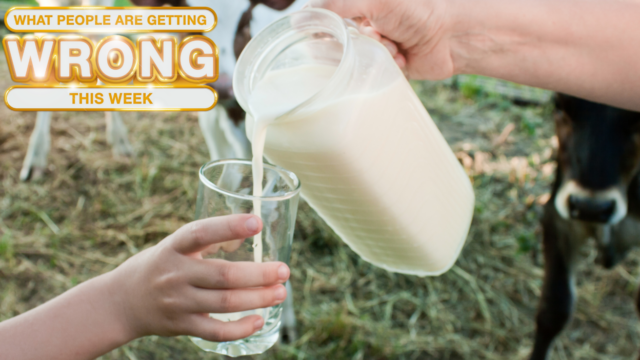
On April 1, the World Health Organization was informed of the first case of an avian influenza (H5N1) transmission from a mammal to a human—a Texas cattle worker caught bird flu from a cow infected with the disease. His symptoms were mild, a case of pink eye, but any virus “jumping species,” particularly to humans, is alarming.
Health authorities began monitoring people who come in contact with cattle and poultry regularly, and the CDC advised anyone at risk to use protective equipment and report any illnesses. The virus was discovered in milk too, but pasteurization kills it, and of course health authorities very strongly advise against drinking unpasteurized milk. So guess what more and more people are doing.
In the wake of the discovery of milk infected with bird flu, sales of unpasteurized, “raw” milked spiked, rising between 21% and 65% compared to last years sales at the same time, according to NielsenIQ. Here’s how Mark McAfee, owner of Raw Farm USA in Fresno, California, explained it to the Associated Press, “Anything that the FDA tells our customers to do, they do the opposite.” Which is just great.
Some raw milk advocates argue that raw milk is perfectly safe, but some are consuming potentially diseased milk because it might make them sick. No one has contracted the disease from drinking milk, but that’s not stopping people from trying: McAfee told the LA Times (dude gets around) that “his phone has been ringing off the hook with ‘customers asking for H5N1 milk because they want immunity from it.’”
Wait, people are trying to get bird flu?
It’s hard to follow the logic here, but trying to catch bird flu to keep from catching bird flu in the future suggests they want to expose themselves to a milder form of a disease in order to build up an immunity to it. Like a vaccine, except uncontrolled, untested, and potentially harmful.
Matthew Motta, who studies health misinformation at Boston University, explained the phenomenon like this: “It’s not that people are stupid or ignorant or that they don’t know what the science is… they’re motivated to reject it on the basis of partisanship, their political ideology, their religion, their cultural values.”
I don’t know, Matthew Motta who studies health misinformation at Boston University, rejecting pasteurization based on partisanship seems pretty foolish to me.
Let’s talk about pasteurization, yeah?
I like pasteurization because I never have to think about it. Milk is pasteurized by heating it to 161 F for 15 seconds. This kills the vast majority of bacteria, yeast, molds, and viruses present. We’ve been pasteurizing milk since the late 19th century, and it works really well: in the 1920s, milk-borne pathogens accounted for about a quarter of illnesses in the United States. They’re nearly unheard of in 2024. Here’s a guy in a tie explaining it on TikTok.
Some people, however, believe that the virtues of raw milk outweigh the benefits of pasteurization, and that’s it’s actually safer than pasteurized milk. According to advocacy organization The Raw Milk Institute, raw milk is more nutritious, helps with lactose intolerance, asthma, eczema, allergies, and more. The Raw Milk Institute’s evidence consists of “numerous first-hand reports,” as opposed to scientific research, because there is no reliable evidence that supports any of the raw milk advocates’ claims. Here are some people in t-shirts explaining it on TikTok.
Raw milk and the law
Whether you can legally sell raw milk varies from state to state. Over here in freedom loving California, it’s perfectly legal to buy and sell raw milk. The totalitarian socialists in Alabama, though, have outlawed it for human consumption.
In the last month, the state governments of Iowa, Louisiana, and Delaware have either passed or are trying to pass laws to legalize the sale of raw milk for human consumption. Lawmakers cite the potential benefits to dairy farmers and the concept of “food freedom,” letting people eat and drink whatever they want.
Well, why can’t people drink whatever milk they want?
I like freedom, and I would normally encourage raw milk fans, people from the “wellness community,” doomsday preppers, anti-FDA activists, this guy, really anyone I don’t approve of, to drink as much raw milk as they like. Go nuts. Feed it to your children. Give yourself bovine tuberculosis. Enhance your gut biome with a raw milk enema. See if I care.
But the recent appearance of bird flu in milk changes the equation. While there are no reported cases of anyone contracting bird flu through drinking milk, and no reported cases of human-to-human transfer either, both are possible, and every transmission of a virus into a new host (human, animal, or whatever) increases the chances that it will mutate into something worse. Something more contagious, that spreads from person to person.
The positive side of cow-based transmission of bird flu
Given the COVID-era hysteria over masks, I’m not hopeful that members of the raw milk community will weigh the competing values of freedom and responsibility and decide to inconvenience themselves even slightly because it could help another person not die. But it is encouraging that so many governmental agencies have responded so quickly to the threat. Civic order has not completely collapsed: the Agriculture Department, the Centers for Disease Control and Prevention, the Food and Drug Administration, and the Administration for Strategic Preparedness and Response (and that’s just the federal agencies) have all mobilized seemingly quickly with reasonable precautions like testing cattle and people who work around them, providing PPE, and establishing guidelines on transportation of infected cattle. All of this lessens the chances that anyone will have to repeatedly explain why it’s actually bad to drink infected milk to people who respond by saying “I have rights.”







